#composablecommerce
Explore tagged Tumblr posts
Text

Composable Commerce: Why It’s the Future of eCommerce Architecture
In today’s fast-moving digital world, traditional eCommerce platforms are hitting their limits.
If your team is stuck with inflexible tech or struggling to scale, it’s time to explore Composable Commerce — a modular, API-first approach that lets you build your store your way.
What is Composable Commerce?
Composable Commerce allows brands to integrate and manage only the best tools for each part of their eCommerce system. That means:
You’re no longer tied to one all-in-one platform
You can replace or upgrade individual services without breaking your site
You get better performance, scalability, and user experiences
This is especially helpful for B2B eCommerce and brands that need customized workflows, flexible pricing, and advanced integrations.
💡 Think of it like LEGO blocks — you choose the best piece for search, checkout, CMS, and so on — and connect them with APIs.
Why Developers and Brands Are Adopting It
With Composable Commerce, developers can use their favorite frameworks (React, Vue, Next.js) and connect them to tools like Stripe, Contentful, or Algolia.
Business teams benefit too:
Faster launches
Easier testing and experimentation
Better user experiences
Less dependency on legacy systems
This approach aligns perfectly with headless commerce and Progressive Web Apps (PWAs) — both of which Wagento supports. Check out their PWA Development Services to see how they help brands go mobile-first.
Recommended Reading
Wagento published a comprehensive guide that breaks everything down in simple terms:
👉 What is Composable Commerce? A Simple Guide for eCommerce Brands
It explains:
What composable means
When to use it
How to start transitioning away from monolithic systems
Looking to Modernize Your eCommerce?
Here are more useful resources from Wagento:
B2B eCommerce Services
Magento Development
BigCommerce Implementation
Adobe Commerce Solutions
If you're building the next generation of eCommerce, it's time to go composable.
1 note
·
View note
Text
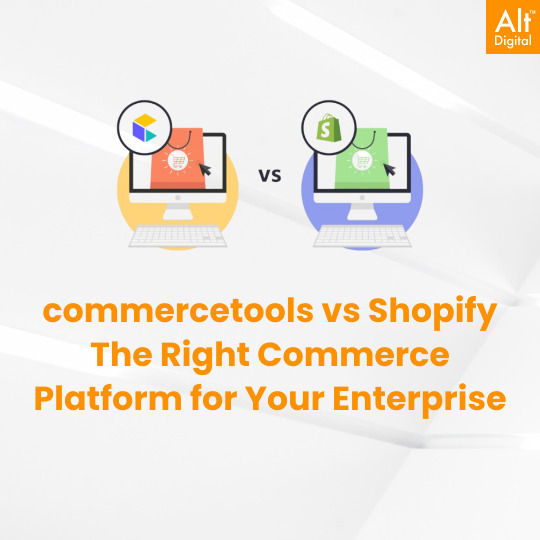

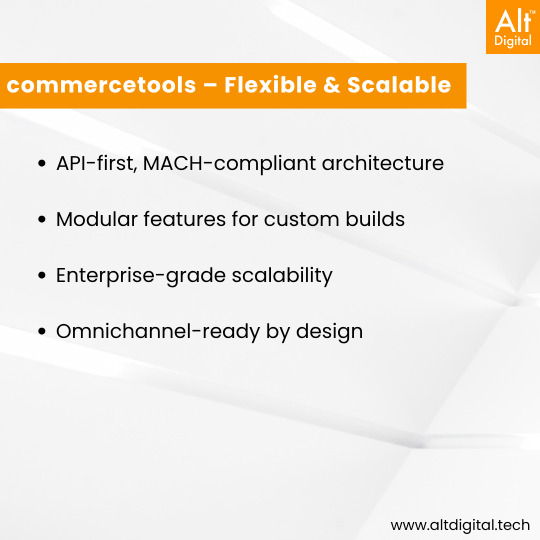
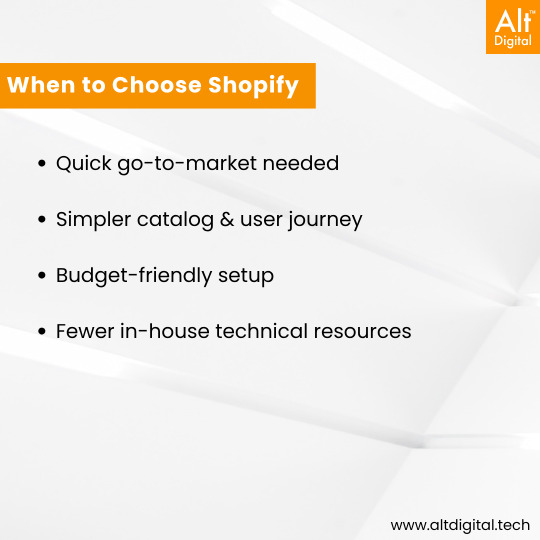
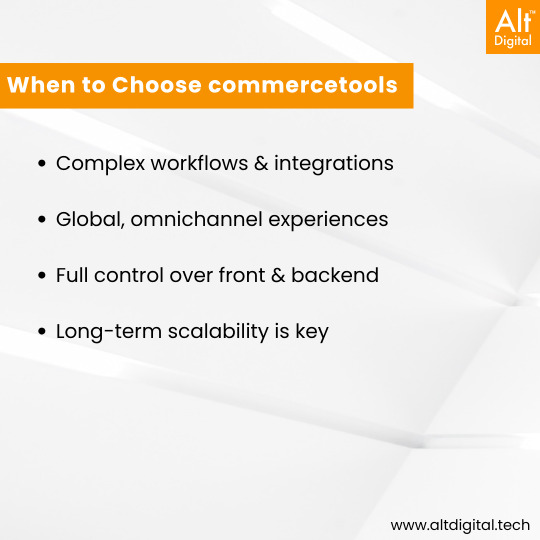
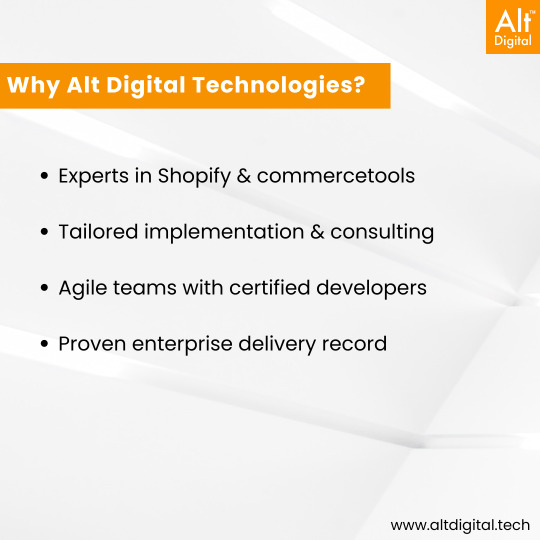

🔍 commercetools vs Shopify — Which platform powers your growth best?
At Alt Digital Technologies, we help enterprises navigate complex tech choices with clarity and confidence.
Need total flexibility, scalability, and headless architecture? commercetools is your match.
Looking for speed, simplicity, and quick market entry? Shopify delivers.
💡 Explore our visual breakdown to choose what’s right for your business goals.
Let’s shape future-ready commerce together.
#commercetools #Shopify #DigitalCommerce #AltDigital #ComposableCommerce #EcommerceSolutions #EnterpriseTech #TechThatScales
#commercetools#Shopify#DigitalCommerce#AltDigital#ComposableCommerce#EcommerceSolutions#EnterpriseTech#TechThatScales
0 notes
Text
[Blog]What Is a Composable Commerce? A Simple Guide for eCommerce Brands

Discover how composable commerce empowers eCommerce brands to build agile, scalable, and customer-centric digital experiences. This guide from Wagento explains how modular, API-driven architecture enables retailers to adapt quickly, reduce costs, and deliver personalized shopping journeys. Ideal for businesses seeking flexibility and innovation in a rapidly evolving market. Read the full blog here at Wagento.
#ecommerce#digitalcommerce#composablecommerce#businessgrowth#businessstrategy#modularcommerce#ecommercetechnology
0 notes
Text
0 notes
Text
The Future of eCommerce: Why Composable Commerce is the Key to Long-Term Success
In today’s hyper-digital landscape, eCommerce businesses must be agile, innovative, and customer-centric to stay competitive. Yet, many brands still rely on SiteGenesis, an aging monolithic architecture that limits growth and adaptability. The question is no longer if you should migrate to Salesforce B2C Composable Commerce, but when and how to do it strategically.
The Limitations of Legacy Systems
For years, SiteGenesis has been a staple for digital retailers, but the industry has evolved beyond its capabilities. Businesses today need:
Agility: The ability to integrate best-of-breed solutions that cater to changing market needs.
Performance: Faster load times and optimized user experiences that drive conversions.
Scalability: A future-proof architecture that supports growth without friction.
Composable Commerce is not just a trend—it’s the next evolution of digital retail. By decoupling the frontend and backend, businesses gain the flexibility to build, customize, and iterate at their own pace.
The Strategic Advantage of Composable Commerce
Transitioning from SiteGenesis to Composable Commerce isn’t just about upgrading technology—it’s about future-proofing your business. Companies that make the move benefit from: ✔️ Seamless Integrations: Connect AI-driven tools, personalization engines, and next-gen analytics effortlessly. ✔️ Omnichannel Experiences: Deliver frictionless customer journeys across multiple touchpoints. ✔️ Innovation at Speed: Adapt to market trends faster than ever before.
Royal Cyber’s Thought Leadership in eCommerce Transformation
As a trusted Salesforce partner, Royal Cyber has developed proven accelerators that simplify the migration journey. Our pre-built React Storefront Components help businesses transition smoothly, ensuring minimal disruption and maximum impact.
What You’ll Learn in Our Exclusive Webinar:
The business case for moving beyond SiteGenesis.
How Composable Commerce revolutionizes scalability and performance.
Real-world success stories from brands that have successfully migrated.
A live demo showcasing the future of eCommerce.
Insights from Salesforce and Royal Cyber experts.
Now is the Time to Act
The future of digital commerce is composable. The brands that embrace it today will define the industry tomorrow.
Join us for this exclusive webinar and gain the insights needed to lead your organization into the future of eCommerce.
0 notes
Text
Is Composable Commerce just a buzzword or a Future?
Composable Commerce is transforming digital #retail! By breaking down the rigid structures of traditional eCommerce into modular components, retailers gain the flexibility to craft unique, seamless, and customer-centric shopping experiences. As consumer expectations evolve, #businesses can adapt, scale, and innovate faster than ever.
Read the article to see how Composable Commerce is shaping the future of online retail.
0 notes
Text
#ComposableEnterprise#EnterpriseApplicationDevelopment#DigitalTransformation#MACHArchitecture#CloudNative#Microservices#BusinessAgility#APIFirst#SoftwareDevelopment#EnterpriseSoftware#FutureOfTech#ITInnovation#ComposableCommerce#HeadlessArchitecture#TechLeadership#EnterpriseITSolutions#AgileDevelopment#ScalableTechnology#USABusiness#TechInnovationUSA#EnterpriseITUSA#DigitalTransformationUSA#CloudComputingUSA#SoftwareDevelopmentUSA#AIforBusiness#FutureOfWork#TechSolutionsUSA
1 note
·
View note
Text
Boost Your E-commerce with Spryker – The Future of Digital Commerce
Are you looking for a powerful and flexible e-commerce platform to scale your business? Spryker is the next-generation composable commerce solution, helping enterprises build, innovate, and expand their online presence seamlessly.
At SkillNet, we partner with Spryker to provide businesses with a cutting-edge commerce experience tailored to their unique needs. Whether you're in B2B, B2C, or marketplace commerce, Spryker’s modular and API-driven approach ensures fast implementation, scalability, and superior customer experiences.
Why Choose Spryker for Your Digital Commerce Needs?
✔ Composable Commerce – Customize your e-commerce platform with modular components. ✔ Headless & API-First – Enables seamless omnichannel experiences across web, mobile, and IoT. ✔ Fast Go-to-Market – Accelerate digital transformation with ready-to-use capabilities. ✔ AI-Powered Personalization – Enhance customer engagement and sales conversion. ✔ Future-Proof Scalability – Expand globally with a platform designed for growth.
SkillNet + Spryker – Your Trusted E-commerce Partner
As a trusted Spryker partner, SkillNet specializes in implementing tailored commerce solutions for enterprises looking to optimize their online presence. Our expertise in digital transformation, platform migration, and custom development ensures your business stays ahead of the competition.
Discover More
🚀 Learn about SkillNet's Spryker Services 🛒 Explore Composable Commerce Solutions 📈 Read our Case Studies on E-commerce Success 🔍 Understand Why Enterprises Choose Spryker
Take Your E-commerce to the Next Level!
Get in touch with our Spryker experts at SkillNet to unlock new growth opportunities for your business.
📞 Contact Us Today! 👉 SkillNet Inc.
#Spryker#EcommerceSolutions#ComposableCommerce#HeadlessCommerce#DigitalTransformation#EcommercePlatform#SkillNet#APICommerce#B2BEcommerce#B2CEcommerce#MarketplaceSolutions#FutureOfCommerce#RetailTech#TechInnovation#BusinessGrowth#EcommerceDevelopment#EnterpriseSolutions#DigitalCommerce#OmnichannelCommerce#ScalableCommerce
0 notes
Text
0 notes
Text

Top 10 Benefits of Switching to Headless Architecture
Switching to headless architecture offers numerous advantages for businesses looking to enhance their digital experiences and streamline their operations. Here are the top 10 benefits:
Unleashing Front-End Potential
Delivering a True Omnichannel Experience
Cost Optimization
Maintaining Agility at Scale
Enhanced Flexibility
Faster Time-to-Market
Personalized Customer Experiences
Composable Commerce
Simplified Multi-Site Management
Performance Gains
Embrace headless architecture to unlock these benefits and transform your digital presence. Know More- https://gowide.com/10-reasons-to-move-to-a-headless-architecture/
0 notes
Text
As the online retail landscape evolves, personalized experiences take center stage. To meet these demands, composable storefronts are becoming essential, with 70% of retailers prioritizing them for enhanced customer experiences.
Salesforce Composable Commerce offers a headless solution, allowing businesses to create modular, flexible storefronts. With benefits like improved performance, quick time-to-value, and control over brand experiences, Composable Storefronts are the future of e-commerce.
For complete insights into the future of Salesforce Composable Storefronts, refer to our recent blog.
0 notes
Text
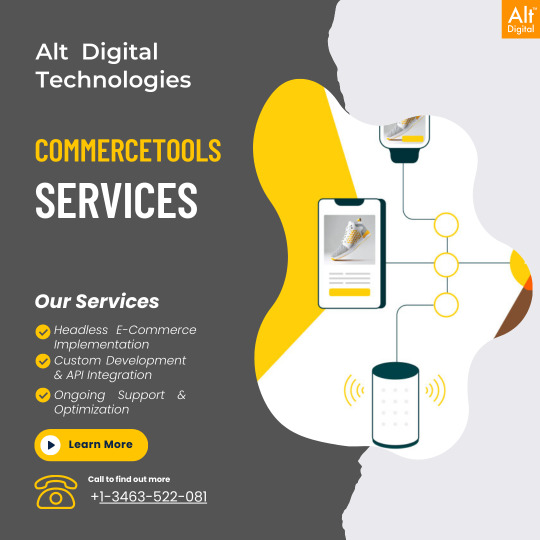
🌐 Powering the Future of Commerce with Composable Commerce 🌐
At Alt Digital Technologies, we believe in creating tailored commerce experiences that adapt to your business's and customers' evolving needs. That’s why we’re proud to offer Commercetools services, bringing the power of headless, API-first, and microservices-based architecture to your digital strategy.
🚀 What can Commercetools do for you?
Flexibility & Scalability: Design dynamic, omnichannel experiences that grow with your business.
Speed to Market: Launch new features and innovations faster than ever.
Future-Proof Solutions: With a modular and customizable commerce platform, stay ahead of trends.
Our expert team at Alt Digital Technologies ensures seamless implementation, integration, and optimization, enabling you to deliver unmatched customer experiences.
✨ Ready to revolutionize your eCommerce journey? Let's build something extraordinary together.
#ComposableCommerce #Commercetools #AltDigitalTechnologies #DigitalCommerce #eCommerceInnovation #HeadlessCommerce #CustomerExperience #DigitalTransformation
1 note
·
View note
Text
What is Composable Commerce?
Composable Commerce can be best described as a paradigm shift that empowers businesses to create and deliver seamless, personalized, and exceptional digital experiences for their customers. It is an approach that breaks free from the limitations of traditional monolithic commerce systems, opening doors to unparalleled flexibility, agility, and growth.
Introducing Composable Commerce
Composable Commerce can be defined as an innovative approach that empowers businesses to create tailored commerce solutions by assembling flexible, interchangeable components. Its key principles revolve around modularity, interoperability, and the ability to compose and recompose commerce functionalities based on specific business needs. It embraces a granular and decoupled architecture that enables businesses to achieve unprecedented flexibility and customization.
In contrast to traditional commerce systems, Composable Commerce stands out due to its modular and API-driven approach. Rather than being bound by rigid monolithic structures, Composable Commerce allows businesses to integrate best-of-breed components seamlessly. This freedom from vendor lock-in enables faster innovation, easier adaptation to market changes, and the ability to leverage specialized services and technologies.
Adopting a Composable Commerce approach brings forth numerous benefits for businesses:
Flexibility and agility: Composable Commerce enables quick adaptation to customer expectations and market demands through easy assembly and disassembly of components.
Scalability and customization: Businesses can scale specific components independently, optimizing resource allocation, and deliver personalized experiences with the modular nature of Composable Commerce.
Faster time to market: Streamlined development processes in Composable Commerce reduce time and effort for introducing new features, giving businesses a competitive edge.
Enhanced customer experience: Composable Commerce allows for seamless, personalized experiences across touchpoints, optimizing conversions and ensuring customer satisfaction.
Implementing Composable Commerce
Before diving into implementing Composable Commerce, it's crucial to assess your business needs and evaluate if it aligns with the principles and benefits of this approach. Understand your current commerce systems, pain points, and desired outcomes to determine if Composable Commerce is the right fit for your organization.
A well-thought-out plan and strategy are essential for a successful transition to Composable Commerce. Identify key stakeholders, set clear goals, and establish a roadmap for implementation. Consider factors such as resource allocation, timeline, and potential challenges, and outline a comprehensive strategy to guide the transition process.
Steps involved in implementing Composable Commerce
Identifying and selecting the right components
Integrating existing systems with Composable Commerce architecture
Testing and optimizing the system
Ensuring security and scalability
By following these steps, businesses can embark on a successful journey to implement Composable Commerce. Remember, careful planning, alignment with business needs, and a systematic approach are key to achieving a seamless transition and reaping the rewards of Composable Commerce.
2 notes
·
View notes
Text
Composable vs Headless Commerce: What’s Best for Your eCommerce Site?
Traditional eCommerce platforms have provided a one-size-fits-all solution for some time. While providing seamless functionality for eCommerce sites, it was difficult to scale and make changes.
Many organizations also found a disconnect between what they did internally and what customers saw externally. For example, one platform might have great customer-facing tools, but be lacking in back-end administration functionality, or vice versa.
As consumer behavior and online trends change, businesses need a fast way to adapt. Having to relaunch an entire platform takes time and may not be able to handle the evolving way businesses operate. For example, using a traditional commerce platform, it can be very challenging to integrate new sales channels. Headless and composable commerce makes it easy to sell across multiple channels.
Read Full Blog at https://www.skillnetinc.com/en/composable-vs-headless-commerce-whats-best-for-your-ecommerce-site/
0 notes
Photo

Universal Commerce brings together the best-in-class MACH and API platform capabilities in the Commerce ecosystem to enable businesses to compose, build and operate high performance cloud-native digital commerce applications that scale. see more: https://universalcommerce.com/
0 notes
Photo

Here is "The 2021 best-of-breed Composable Commerce Stack" I've been working on putting together over the holidays! Join the conversation on LinkedIn! #composablecommerce #headless #ecommerce #commerce #cms #jamstack #martech #infographic #marketing
0 notes